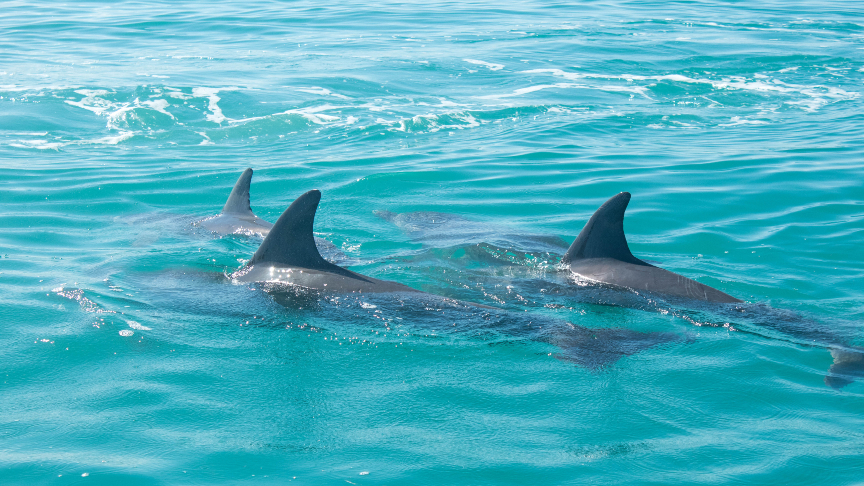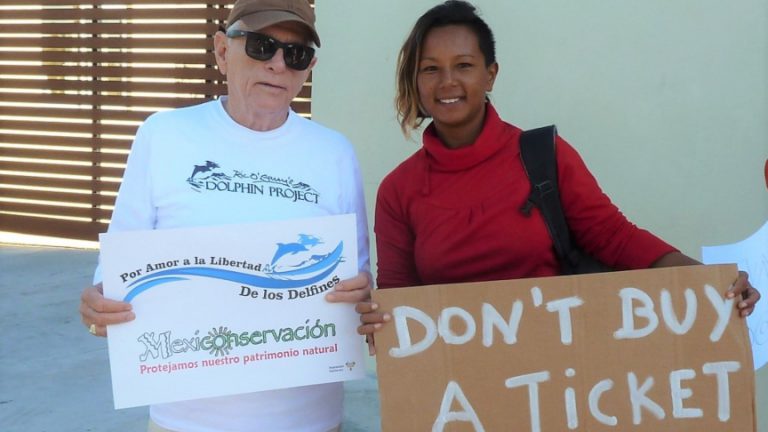Swimming with dolphins? Read this first
Guest blog Tuul Luna
People regularly ask us where they can swim with dolphins in Mexico. Unfortunately that’s not possible here in the wild, and we are absolutely against the dolphinariums dolphin prisons. We regularly encounter dolphins in the wild on our excursions and that is like a gift from nature every time it happens, in our opinion it's the only right way to see dolphins.
Our friends and colleagues from Tuul Luna have written an extensive blog about swimming with dolphins in captivity that leaves no room for doubt: just don't do it! Below we have largely copied the arguments and counterarguments from their blog with some updates and additions from our side. Read the truth behind the dolphinariums (in Mexico). And please: #dontbuyaticket
Flipper
Do you know someone who doesn't love dolphins? We don’t. Dolphins are intelligent, playful and they are super charismatic with their eternal smile! But don't be fooled. Dolphins don't have facial muscles so it just looks like they're always smiling and happy. The only mistake of Mother Nature...
Dolphins are mammals and are among the cetaceans. There are around 40 species in the world, the most famous one is the bottle nose dolphin (Tursiops Truncatus), more commonly known as "Flipper", named after the TV series of the same name from the '60s.
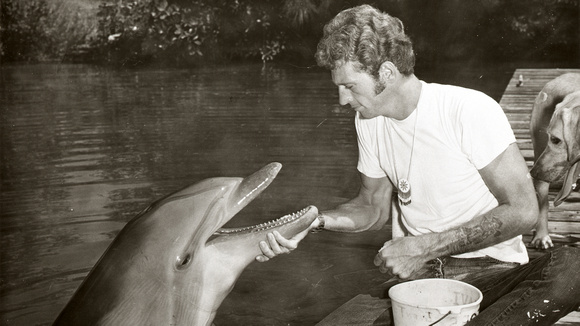
In this series, five dolphins played the role of Flipper, trained by Richard O'Barry. While running the series, one of the dolphins died in the arms of his trainer. Richard has since been left with an immense sense of guilt. He realized that this dolphin had chosen to leave life. Dolphins are very self-aware animals. They recognize themselves in a mirror and they also know very well when to swim to the surface of the water to breathe. The dolphin in question had chosen not to breathe any further. This meant the end of the life of this dolphin, but unfortunately only the beginning of the big dolphin exploitation.
Alarming numbers
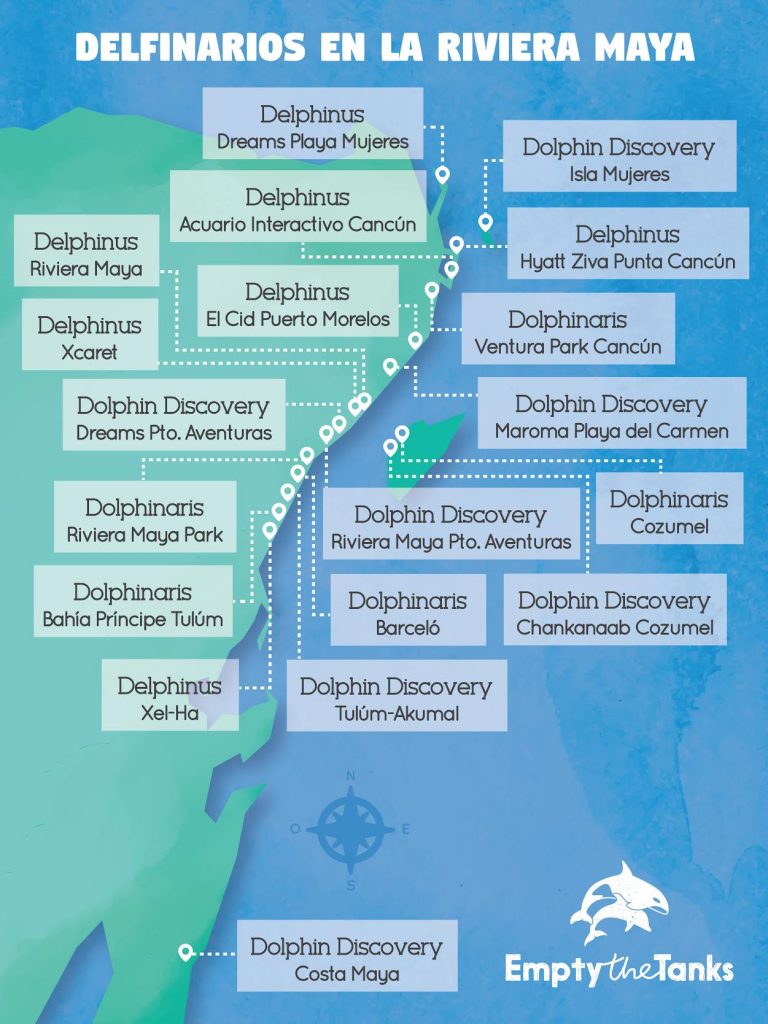
With the success of the series, more and more dolphinariums were created. In some regions such as the Riviera Maya where we are, you will find a dolphinarium almost every 3 miles! There are now 19 of these facilities in total, all owned by 3 large companies: Dolphinaris (5), Delphinus (7), and Dolphin Discovery (7). "Swimming with dolphins" is the best-selling tour in Cancun and the Riviera Maya. Really, together these dolphinariums are visited more than Chichen Itzá, one of the seven new wonders of the world! This activity may also be on your wish list, but if you really love dolphins, don't participate in the abuse of these poor animals.
"What do you mean abuse"?
Where do the captive dolphins really come from? Dolphinariums usually say their dolphins have been born at the dolphinarium. However, this applies only to a small part of the animals. Most of the dolphins that entertain you were once wild and free. To meet the increasing demand, many of them are abducted illegally.
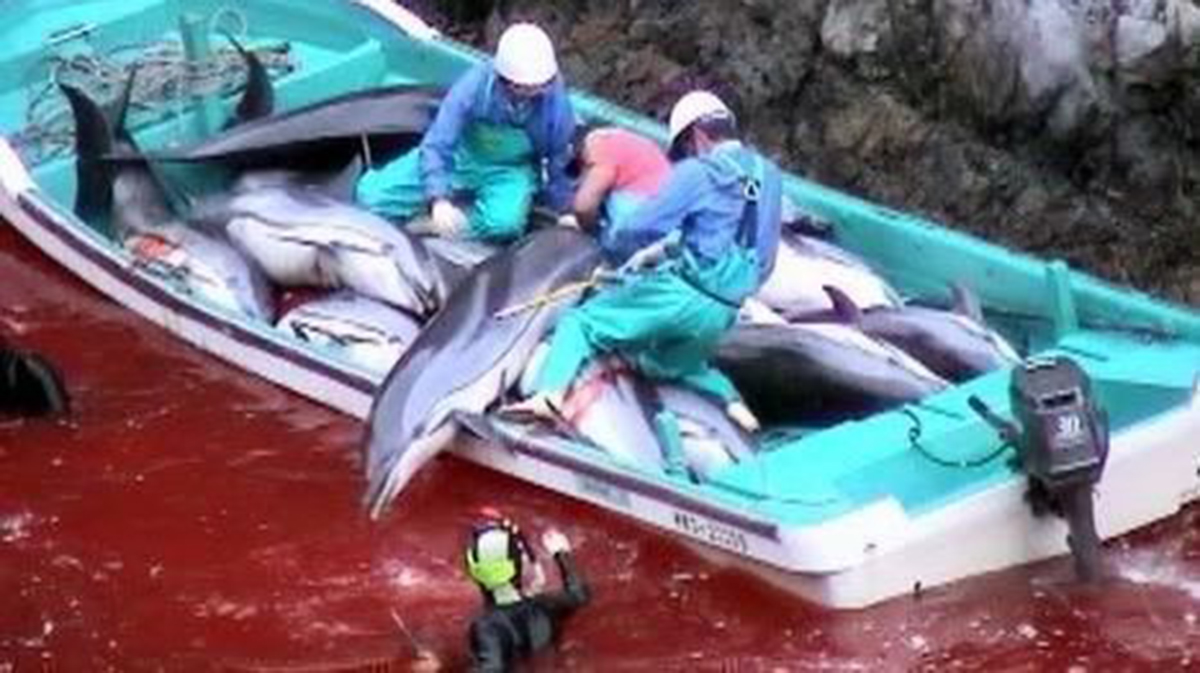
The process of imprisonment is extremely cruel and violent. Dolphins are separated from their families with whom they live closely together, which has a negative effect on the entire herd. A few dolphins are separated from the group, chased to exhaustion by boats and finally they get caught in nets. The dolphins are already injured here and death from drowning is no exception. After this traumatic experience, they embark on a nerve-racking journey in small boats, closed trucks or planes, to be dumped at a destination in a mini pool. Here they often have to live together with other dolphins from another clan with whom they often do not get along. In short, from the "kidnapping" these poor animals live under a lot of stress.
"What do you mean a small swimming pool? It's bigger than our resort's!"
Dolphins cover daily distances between 35 and 100 miles (60 and 160 km) in the wild, at 25 mph (40 km/h) and can dive up to 300 ft (90m) deep. This is impossible in the limited space they get in a dolphinarium. An average tank is 30 by 30 feet (10 by 10 meters) and often only 6 feet (2 meters) deep. This means that they can only rotate in circles. Dolphins go crazy and depressed in the small space in which they live. Compare it to locking a person in a 6 by 6 feet room. Wouldn't you go crazy too?

At some dolphinariums they have built a small lake where the dolphins have more space but this is never enough! In addition, these shallow baths heat up quickly at many exotic destinations, which is very unpleasant for the dolphins and which can lead to death again. In nature they would dive to cooler waters but that is not possible here. No swimming pool or lake can ever be large enough to replace the ocean! By the way, have you ever seen how they clean such a swimming pool with dolphins in it?
"But this is my chance to touch my favorite animal"
As humans we are born with the natural urge to touch everything. However, you must understand that dolphins and many other aquatic animals (sharks, sea turtles, fish, etc) have a gelatinous protective layer on their skin that functions like snot in our nose. This layer can repel bacteria or toxic components. However, our pH values are very acidic for them. Because a dolphin is touched by people all day long, this protective layer is affected, causing major damage. In many dolphinariums, they feed the dolphins a daily dose of antibiotics to be able to resist all this touching. Let that sink in for a bit...
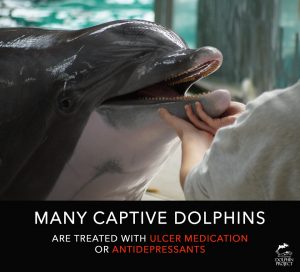
But the other way around is also not good: dolphins can infect us with bacterial diseases such as salmonella. Dolphinariums will certainly not inform people of the danger to your health. What they most likely do is add chlorine to their tanks to keep the bacteria level somewhat safe for humans. But you guessed it, this chlorine also causes significant injuries to the skin and eyes of our dear friends. They can become completely blind. Is that touch really worth all this animal suffering? Learn to enjoy with your other senses, find them in their habitat and keep your hands to yourself.
"But dolphins are well cared for and fed in dolphinariums"
The dolphins are fed but how do you think they learn tricks? If they don't give you a kiss, they won't get anything on their plates, no rewards, nothing, nada! Hunger is often encouraged so that their training for tricks remains effective. Frozen fish is on the menu of a caught dolphin and is only given if they do their job well. In the open ocean the dolphins go in search of fish, which is healthier and the hunting also has a stimulating effect.
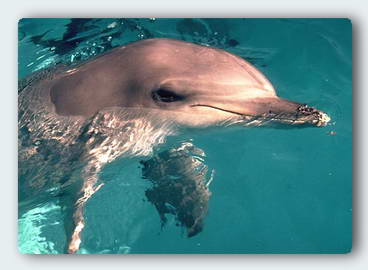
Dolphinariums often want to make it seem that dolphins live longer in detention because they can intervene in case of illness, but this is also wrong. Dolphins can live to be 50 to 60 years old in the great outdoors. There are many stillbirths in captivity and many only live up to 20 years old. The dolphins are indeed treated with drugs in the case of diseases, but they are usually diseases they would never contract in the wild. Studies have shown that trapped dolphins are frequently given medication for ulcers and depression, something they would never need in the wild. Dolphins (and also orcas) often exhibit self-destructive behavior in captivity. They refuse to breathe, jump out of their tank, they keep knocking their heads against the walls... They are often so sad that they don't wish their offspring the same fate. At the birth of a dolphin, the mother normally pushes her baby to the surface of the water so that the baby can take its first breath. Unfortunately it often happens in dolphinariums that the mother refuses to do this because she does not want this life in captivity for her baby. Working for twenty years as a slave for someone's entertainment without a day off, would you do it to your offspring?
"But it is educational"
Have you ever considered what they teach you in a dolphinarium? The purpose behind a dolphinarium is not to be educational, their purpose is purely commercial. In dolphinariums they’ll tell you that the dolphins (already half on dry land) are bouncing back and forth with their fins because they want to greet you, that the squeaking noises they make are their way of expressing that they want to communicate with you and that they swim towards you with enthusiasm because they are eager to get to know you... Really? A three year old might believe it, but do you? These are tricks taught by the aforementioned conditioning.
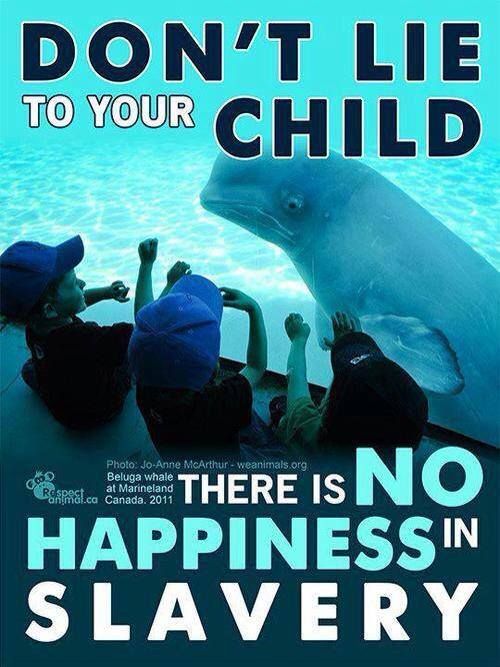
Moreover, these tricks are a reflection of our human behavior and try to tap into our emotions. However, none of these attitudes form part of their natural behavior. If you really want to learn something about dolphins, watch a "Blue Planet" documentary or book a tour where you can find them in their natural habitat. Certainly a good guide with a lot of passion can explain how they really behave in the place where they belong.
"I've been to a dolphinarium and they explained something completely different"
Dolphinariums are trying to present themselves as centers of science and education, even as safe havens for these poor animals that would be nothing without them. They will try to convince you in every possible way that the dolphins that live here are happy and that they are well cared for. In some facilities, they even claim that the dolphins are released into the open sea in the evenings and that they choose to return the following day themselves. Dolphins are not chickens though!
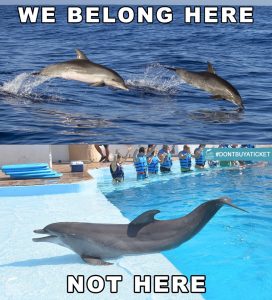
A lot of money is invested into marketing and they have no shame to lie. Slogans such as "For a better planet" are full of irony in our opinion. How can you ensure a better planet if you use captive animals as slaves? Often times “rescued” manatees and sea lions are kept in such dolphinariums as well. These animals should boost the credibility of the dolphinarium. Saving and caring for animals is of course not a negative thing, but these animals too often live in too small spaces and are also often used for entertainment. Taking an animal to a sanctuary because it is injured, or attempting to save an animal from extinction is one thing, pulling a perfectly healthy animal from its habitat to exploit for your entertainment is a different matter... Learn the difference!
"But swimming with dolphins is therapeutic?"
Dolphin Assisted Therapy or DAT is a program whereby adults and children with autism, physical disorders or depression can be treated by the intervention of a dolphin. Betsy Smith was the founder of this program. In 1971 she saw positive results with her mentally handicapped brother and started offering DAT for free in two dolphinariums in Florida. Other facilities saw the possibility of earning a load of money with this and also started offering DAT.
In 2003, however, when Smith realized that this DAT did not improve long-term patients and that the dolphins were being exploited, she wisely decided to withdraw from this program. But dolphinariums are not going to inform us of this counter study. If you are looking for animal therapy, give the person you want to help rather a dog from the shelter: you save an animal and it will give the same magical effect ... Two birds with one stone. Moreover, this puppy can share his entire life with you - not just a brief moment - which will also have an effect on a much longer period of time.
"I can't deny my children this experience, can I?"
Sure you can! Everything starts with education, so it is entirely in your hands. It is up to the parents to teach their children and show them what is right and what is wrong. Who will still take their children to a circus with wild animals in 2023? Everyone by now knows how these animals are doing. The same applies to dolphins.
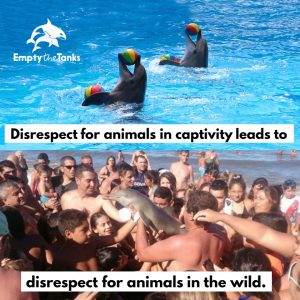
They should not suffer for our entertainment. In addition, as already mentioned, the smile around a dolphin's mouth is usually misinterpreted. The audience assumes that they are always gentle and willing playmates. But as said, this is an anatomical phenomenon, not a reflection of their emotional state. Just think of the sad clown under his face mask. Many of them were once wild animals. Would you put your child in a cage together with wolves or tigers? Dolphins, including those born in captivity, are large, powerful predators that can injure people. Sometimes dolphins express their frustration not only through self-harm, but also through aggression towards people. There are cases where dolphins push people to the depths, jerk their hair or bite them, as recently happened in a dolphinarium in Cancún. If you know someone who already went, just ask them if they could keep their hands anywhere? Probably not. They had to follow the instructions carefully to somewhat reduce the risk for this... and you are going to put your little kid in there?
“I did not know”
Unless you are that one person who has indeed been living under a rock for years, you no longer have any excuses. About twenty years ago you could still keep yourself ignorant, but with the arrival of the internet and smartphones we now have all the information in our pocket. All information is in that small device that we stare at all day. Use it for something useful and inform yourself! Or are you going to keep claiming that the nose of a dolphin is really made to lift your full body weight out of the water?
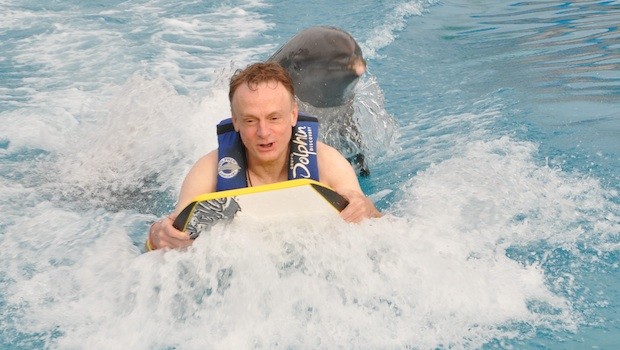
The only thing such a dolphinarium wants from you is your money. Their concern for animals is pure show! This is a multi-million dollar business.
Still not completely convinced?
Watch the documentary "The Cove" by Richard O'Barry. This Oscar-winning film from 2009, tells about the hunt for dolphins in Taiji (Japan). From here, dolphins are sold worldwide to fill dolphinariums and the ones that aren’t deemed pretty enough are slaughtered at the spot.
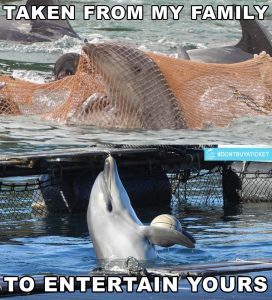
So don't make the same mistake as Richard. He has been fighting for years to cancel out the "Flipper" effect. On April 22, 1970, Richard launched his first campaign against the dolphins in captivity. Richard is now over 80 years old and still fights against the large dolphinariums around the world. Think before you start and avoid an eternal feeling of guilt! Don't buy a ticket! Where there is no demand, the supply will disappear!
How can you help?
At Tuul Luna Ecotours and Underwater Mexico we stand behind animal welfare in general. If you go on a tour with us, you’ll see for yourself.
Sources
Swimming with captive dolphins
https://www.dolphinproject.com/campaigns/captivity-industry/swimming-with-dolphins/
The truth behind Mexico’s swim-with-dolphins industry
https://www.dolphinproject.com/blog/truth-behind-mexicos-swim-with-dolphins-industry/
The Disturbing Truth Behind Your Swim With The Dolphins
https://www.thedodo.com/swim-dolphins-caribbean-1094674999.html
What This Veterinarian Saw at SeaWorld Orlando Isn’t Pretty
https://www.seaworldofhurt.com/features/veterinarian-visits-seaworld-orlando/
Report on captive dolphins in Mexico 2015
https://www.readkong.com/page/report-on-captive-dolphins-in-mexico-2015-7937120



